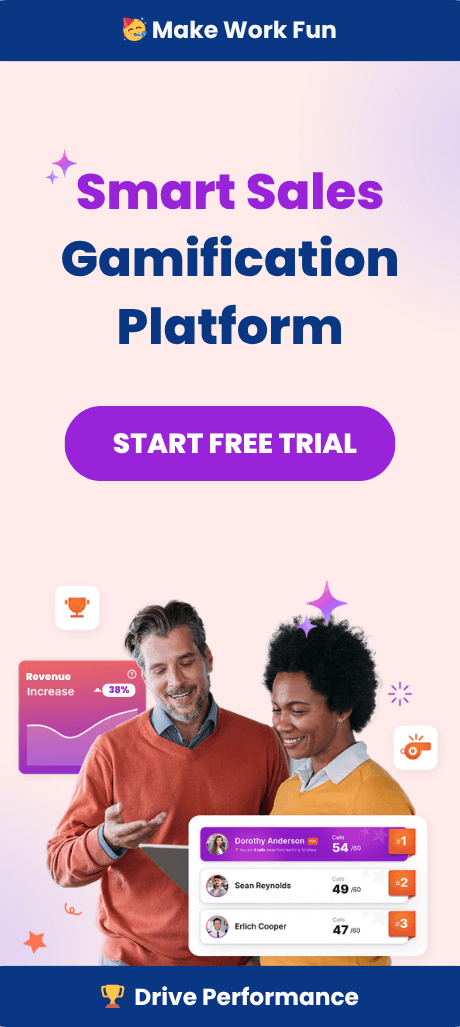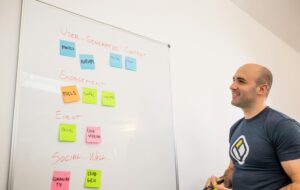In today’s competitive sales landscape, leveraging the right tools and strategies is essential to drive performance, enhance employee engagement, and ensure the successful adoption of your CRM system. One such powerful strategy is gamification—the integration of game-like elements into non-game contexts. When applied to Salesforce, gamification can transform routine tasks into engaging challenges, foster healthy competition, and significantly boost Salesforce adoption. This comprehensive guide will walk you through why to gamify Salesforce, the gamification benefits it brings, such as enhanced employee engagement and productivity, and how to implement it effectively.
Table of Contents
- Why Gamify Salesforce?
- The Basics of Salesforce Gamification
- Why Advance Beyond the Basics in Salesforce Gamification?
- Step-by-Step Guide to Implementing Gamification in Salesforce
- 1. Choose the Right Gamification Tool
- 2. Pick the Right KPIs to Gamify
- 3. Create Competitions
- 4. Celebrate Achievements
- 5. Set Up Reward Stores and Rewards
- 6. Add Badges and Points Systems
- 7. Check Analytics to Measure Performance
- 8. Use AI to Automate and Generate New Ideas
- 9. Use the AI Coaching Agent for Personalized 1:1s
- Final Thoughts
What is Gamification?
Definition and Explanation of Gamification
Gamification is the use of game design elements and mechanics in non-game contexts to engage and motivate people to achieve specific goals or behaviors. It involves applying game principles, such as rewards, challenges, and competition, to non-game situations to increase participation, engagement, and loyalty. By incorporating elements like points, badges, and leaderboards, gamifica 6tion transforms routine tasks into engaging activities, making them more enjoyable and motivating for users. This approach can be applied in various fields, including business, education, healthcare, and marketing, to drive desired outcomes and improve user experience.
Benefits of Gamification in Business
Gamification offers numerous benefits in business, particularly in enhancing employee engagement, boosting sales productivity, and improving customer experience. By leveraging game mechanics, businesses can motivate sales teams to achieve their targets, encourage customers to interact with their products or services, and create a more interactive and enjoyable user experience. For instance, implementing a points system for completing sales tasks can drive sales reps to be more proactive and diligent. Additionally, gamification can help businesses collect valuable data and insights on user behavior, which can be used to inform business decisions and improve overall performance. This data-driven approach ensures that gamification strategies are aligned with business goals and deliver tangible results.
Examples of Successful Gamification Implementations
There are many examples of successful gamification implementations in business. Companies like Salesforce, LinkedIn, and Duolingo have effectively used gamification to engage their users and drive desired behaviors. Salesforce, for example, uses gamification to encourage sales teams to complete training modules and achieve their sales targets. By integrating game mechanics into their training programs, Salesforce ensures that sales reps are continuously learning and improving their skills. LinkedIn uses gamification to encourage users to complete their profiles and engage with their network, enhancing user engagement and platform activity. Duolingo, a language-learning platform, uses gamification to motivate users to learn new languages and achieve their learning goals through interactive lessons and progress tracking. These examples demonstrate how gamification can be tailored to different contexts to drive engagement and achieve specific objectives.
Understanding Salesforce Adoption
Overview of Salesforce and Its Features
Salesforce is a cloud-based customer relationship management (CRM) platform that enables businesses to manage their sales, marketing, and customer service activities in a single, integrated environment. Salesforce offers a range of features designed to support sales teams, including contact and account management, sales forecasting, marketing automation, and customer service and support. With tools like sales analytics, sales forecasting, and sales performance management, Salesforce provides sales teams with the insights and capabilities they need to drive sales productivity and achieve their targets. The platform’s robust functionality and user-friendly interface make it a powerful tool for managing customer relationships and optimizing sales processes. By centralizing data and automating key tasks, Salesforce helps sales teams work more efficiently and effectively, leading to better business outcomes.
Why Gamify Salesforce?
Before diving into the how, it’s essential to understand why gamifying Salesforce is a valuable strategy:
- Increase User Adoption:Gamification transforms routine tasks into engaging challenges, encouraging more consistent use of the Salesforce platform. This leads to better data entry, improved CRM utilization, and higher overall adoption rates.
- Enhance Employee Engagement:By incorporating elements like points, badges, and leaderboards, gamification fosters a sense of fun and competition. This heightened engagement motivates sales representatives to perform better and stay active within the system.
- Improve Sales Performance:Gamification aligns everyday activities with business goals. It encourages behaviors that lead to higher conversion rates, more closed deals, and ultimately, increased revenue.
- Create a Learning Experience:New users can learn Salesforce more effectively when guided through interactive tasks and real-time feedback, reducing the learning curve and accelerating proficiency.
Allowing users to personalize their experience and interact with features that foster a sense of ownership and participation is crucial for maximizing the benefits of gamification.
While many gamification tools can help achieve these goals, not all are created equal. Choosing an advanced, feature-rich solution like Spinify can set you up for long-term success.
The Basics of Salesforce Gamification
Salesforce gamification involves integrating game mechanics—such as points, badges, leaderboards, and rewards—into the Salesforce CRM environment. The goal is to increase user engagement, encourage healthy competition among sales reps, and ultimately improve Salesforce adoption within the organization.
Key Concepts:
- Game Mechanics: Elements like points, badges, levels, and leaderboards that provide structure and motivation.
- User Engagement: Strategies to keep Salesforce users actively involved and interested in their tasks.
- Salesforce Adoption: The process of getting all team members to effectively use the Salesforce CRM, leading to better data, improved processes, and higher sales.
Benefits of Basic Gamification:
- Increased Motivation: By rewarding specific behaviors, gamification encourages sales representatives to engage more deeply with Salesforce.
- Improved Data Quality: Gamification techniques push users to input and update data consistently, ensuring accurate records.
- Better Training Experience: New users can learn through interactive tasks and immediate feedback, making onboarding smoother.
Basic gamification is a starting point. However, to unlock the full potential of gamification and address long-term challenges, it’s important to move beyond these basics.
Why Advance Beyond the Basics in Salesforce Gamification?
Basic gamification techniques—like awarding points for calls or badges for closing deals—can spark initial interest among sales teams. However, these simplistic approaches often plateau, failing to sustain long-term engagement or drive significant business outcomes. To truly transform team performance and foster a culture of continuous improvement, organizations need to evolve their gamification strategies. By advancing beyond the basics, you can unlock deeper engagement, greater productivity, and more meaningful results.
While many gamification tools (such as Spinify, Bunchball, and Hoopla) offer ways to integrate game mechanics into Salesforce, the core philosophy behind advancing gamification remains consistent: move from basic point-scoring to a comprehensive strategy that continuously motivates and drives performance.
The Evolution of Gamification: From Basics to Advanced Strategies
1. Moving Beyond Simple Rewards:
- Basic Approach: Initially, gamification might involve earning points or badges for specific actions. While these rewards can increase initial participation, they may lose their appeal over time as the novelty fades.
- Advanced Strategy: To sustain engagement, gamification should evolve into a rich, strategic framework. Instead of merely rewarding a static metric, advanced strategies tailor rewards to meaningful behaviors, align incentives with business goals, and incorporate varied recognition methods that adapt over time. For instance, dynamic leaderboards, interactive tools like prize wheels, and personalized celebrations transform routine tasks into exciting, memorable experiences.
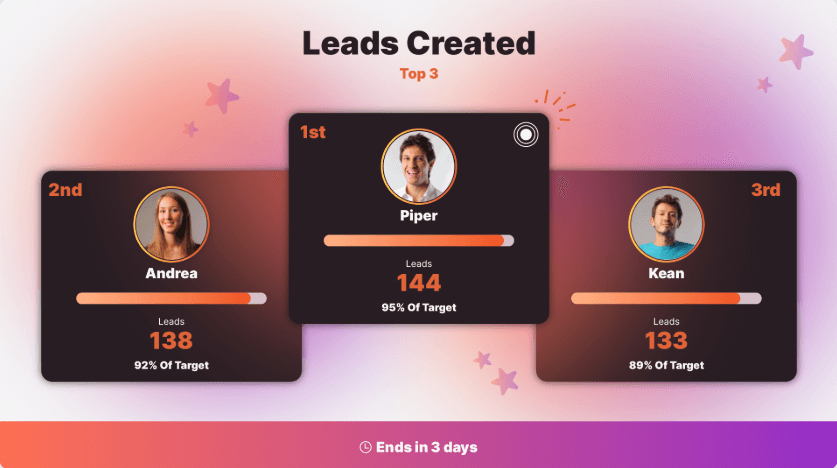
2. Leveraging Real-Time Data and Insights:
- Basic Approach: Early-stage gamification might offer periodic updates on performance. This lag can reduce the immediacy and impact of feedback.
- Advanced Strategy: Modern gamification leverages real-time integration with systems like Salesforce. This provides instant feedback through up-to-the-minute leaderboards, performance grids, and scorecards. Immediate data allows teams to adjust strategies on the fly, managers to offer timely coaching, and employees to see the real impact of their actions as it happens. Tools like Spinify exemplify this with AI-powered insights and automated coaching, but the principle applies broadly across advanced gamification platforms.
3. Creating Engaging Experiences:
- Basic Approach: Traditional gamification might focus solely on leaderboards and static achievements, which can feel monotonous.
- Advanced Strategy: Advanced gamification introduces interactive, engaging elements that make the process fun and dynamic. Features such as prize wheels, celebratory sounds (“ring the gong”), and personalized video achievements create a vibrant environment that maintains excitement. This not only motivates individuals but also fosters camaraderie and healthy competition among team members.
4. AI-Driven Personalization and Automation:
- Basic Approach: Manual setup of gamification elements can be time-consuming and may not adapt quickly to changing needs.
- Advanced Strategy: Utilizing artificial intelligence, modern gamification platforms can automate routine tasks, provide personalized coaching, and suggest innovative ideas. AI-driven tools analyze performance trends, recommend new challenges, and automate one-on-one coaching sessions. This reduces administrative overhead for managers and ensures that coaching and rewards are tailored to each individual’s needs, leading to more effective performance improvements.
5. Continuous Improvement and Support:
- Basic Approach: A static gamification setup may become outdated as business needs evolve.
- Advanced Strategy: Sustainable gamification requires a commitment to continuous refinement. This involves regularly reviewing analytics, gathering user feedback, and adjusting competitions, rewards, and strategies accordingly. Advanced platforms often offer 24/7 global support and ongoing updates to keep the experience fresh, relevant, and aligned with organizational goals.
Benefits of Advancing Your Gamification Strategy
By moving from basic to advanced gamification strategies, organizations experience a range of benefits that directly enhance team performance:
- Higher Salesforce Adoption Rates:
Enhanced, varied, and personalized engagement tactics keep users interacting with Salesforce more consistently, leading to sustained CRM usage and improved data quality. - Superior Data Quality:
Continuous motivation encourages sales reps to regularly update and maintain records accurately, leading to better analytics and decision-making. - Increased Sales Productivity:
Real-time feedback, targeted coaching, and dynamic competitions drive higher levels of sales activity. Teams respond quickly to performance data, adapt strategies, and close deals more efficiently. - A Culture of Continuous Improvement:
Advanced gamification fosters an environment where learning, healthy competition, and self-improvement are integral. Teams celebrate successes, learn from setbacks, and continually raise their performance standards. - Enhanced Employee Engagement:
Interactive features and personalized recognition make work more enjoyable, reducing burnout and increasing job satisfaction. Engaged employees are more likely to be proactive, creative, and collaborative.
Advancing beyond basic gamification transforms how organizations motivate their sales teams within Salesforce. By adopting sophisticated strategies—whether through a platform like Spinify or by applying the same advanced principles—companies can achieve higher engagement, better data quality, increased productivity, and a culture of continuous improvement. These benefits collectively drive sustained success, ensuring that your gamification efforts deliver meaningful and lasting business outcomes.
Step-by-Step Guide to Implementing Gamification in Salesforce
Implementing gamification in Salesforce involves a strategic approach that aligns with your business goals, enhances team performance, and drives sustained engagement. To implement gamification effectively, follow these steps to create a successful gamification strategy that transforms your sales process and boosts results, using advanced platforms like Spinify as a reference for optimal outcomes. Each step includes practical ideas to help you apply these strategies effectively.
1. Select Seamless Gamification Tools to Boost Adoption and Productivity
Why It Matters:
Choosing the right gamification tool is crucial for long-term success. A platform that integrates seamlessly with Salesforce and meets your business needs ensures minimal disruption and maximizes productivity.
Benefits:
- Smooth Integration: Ensures seamless data flow and real-time updates.
- Reliability and Support: Provides robust, 24/7 global support and a proven track record.
Ideas for Implementation:
- Research and Demos: Request demos and trial periods from top-rated platforms like Spinify. Look for customer testimonials and case studies that demonstrate tangible improvements in team performance.
- Stakeholder Involvement: Involve key stakeholders, such as sales managers and IT personnel, in selecting the tool to ensure it meets both technical and motivational needs.
- Integration Testing: Before fully committing, conduct a pilot integration with Salesforce to confirm that the tool interacts smoothly with existing workflows and data.
2. Identify Impactful KPIs for Focused Sales Growth
Why It Matters:
Selecting KPIs that align with strategic goals focuses your team on actions that drive revenue and improve performance.
Benefits:
- Clear Direction: Helps teams concentrate on high-impact activities.
- Measurable Goals: Provides specific targets that motivate and guide daily actions.
- Direct Business Impact: Ensures gamification efforts contribute to revenue growth.
Ideas for Implementation:
- Workshops: Hold workshops with sales leadership to determine which metrics most closely align with business objectives.
- Survey Team Needs: Poll your sales team for feedback on which metrics they believe would most motivate them.
- Prototype Dashboards: Create prototype dashboards reflecting chosen KPIs to visualize how data and progress will be tracked.
3. Fuel Healthy Competition to Drive Continuous Engagement
Why It Matters:
Creating competitions turns everyday tasks into engaging challenges, driving motivation and sustained activity among team members.
Benefits:
- Increased Motivation: Friendly competition spurs higher performance.
- Continuous Engagement: Regular contests keep the team actively involved.
- Collaboration and Camaraderie: Team-based challenges promote collective effort and strengthen group dynamics.
Ideas for Implementation:
- Kickoff Contest: Launch with a high-energy kickoff contest to generate excitement and introduce the new gamification program.
- Varied Formats: Rotate formats between individual, team-based, and mixed competitions to cater to different motivational drivers.

- Thematic Contests: Tie competitions to company events or seasonal themes to keep them fresh and relatable.
4. Boost Morale and Momentum by Celebrating Wins
Why It Matters:
Celebrating achievements reinforces desired behaviors, boosts morale, and encourages continued high performance.
Benefits:
- Positive Culture: Celebrations create a supportive and energetic work environment.
- Sustained Motivation: Recognition drives reps to continue performing at high levels.
- Team Unity: Shared celebrations build camaraderie and collective pride.
Ideas for Implementation:
- Regular Recognition Rituals: Establish weekly or monthly rituals where top performers are celebrated in team meetings.
- Surprise Rewards: Occasionally surprise top performers with unexpected bonuses or personalized thank-you messages.
- Visual Displays: Use digital displays or emails to showcase achievements, including multimedia elements like videos or animations for added impact.
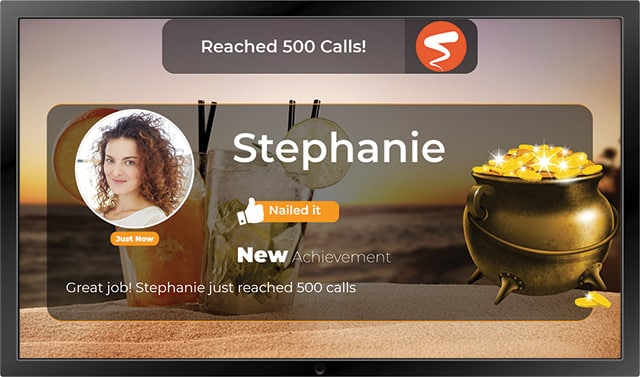
5. Incentivize Success with Tangible Rewards That Motivate
Why It Matters:
Tangible rewards translate achievements into real-world benefits, increasing motivation and reinforcing desired behaviors.
Benefits:
- Tangible Motivation: Real rewards (e.g., gift cards, extra time off) increase commitment.
- Increased Engagement: The opportunity to earn desirable rewards keeps the team motivated.
- Alignment with Culture: Customizable rewards that align with company values boost satisfaction and participation.
Ideas for Implementation:
- Reward Brainstorming: Gather input from your team on what kinds of rewards would truly motivate them.
- Tiered Rewards: Create different levels of rewards for various milestones, ensuring that frequent small rewards keep motivation high while big rewards mark major achievements.
- Easy Redemption: Set up a simple, intuitive reward store interface where reps can track their points and redeem rewards without hassle.
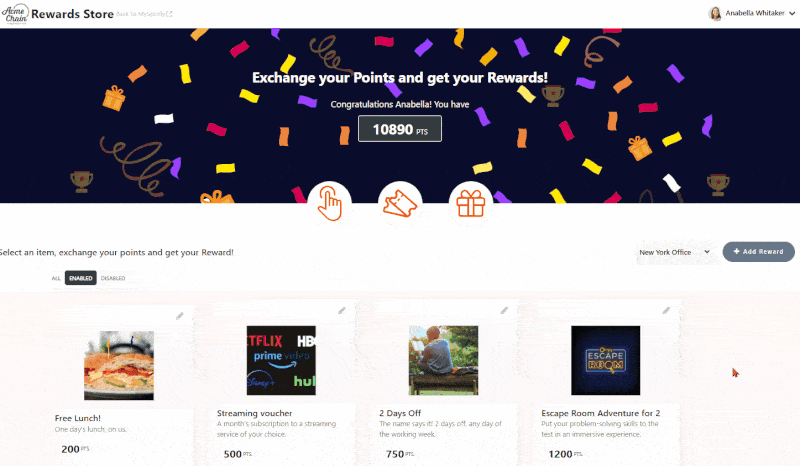
6. Recognize Efforts with Visible Badges and Points for Instant Motivation
Why It Matters:
Visible badges and points systems provide immediate recognition and track progress, fostering healthy competition and sustained effort.
Benefits:
- Immediate Recognition: Badges and points offer instant validation of achievements.
- Sustained Engagement: Visible progress markers motivate continuous participation.
- Encourages Excellence: Clear milestones drive reps to improve, striving for higher status and rewards.
Ideas for Implementation:
- Design Unique Badges: Develop badges that reflect company culture or specific achievements, making them more desirable.
- Leaderboard Visibility: Position leaderboards in common areas or integrate them into frequently used tools to maintain constant visibility.
- Progress Sharing: Encourage reps to share their achievements with peers, further boosting morale and friendly competition.
7. Leverage Analytics for Continuous Improvement and Strategic Decisions
Why It Matters:
Regular analysis of performance data ensures that your gamification strategy remains effective, relevant, and aligned with evolving business goals.
Benefits:
- Informed Decisions: Data insights guide strategic adjustments that improve outcomes.
- Targeted Improvements: Identifying trends and gaps allows for precise coaching and support.
- Optimized Strategy: Continuous feedback loops refine your approach for maximum impact.
Ideas for Implementation:
- Monthly Reviews: Schedule regular review meetings to analyze key metrics and discuss necessary strategy adjustments.
- Dashboards Customization: Tailor dashboards to highlight trends, successes, and areas needing attention for easier interpretation by management.
- Feedback Loops: Implement a system for team members to provide feedback on competitions and incentives, integrating their insights into strategic changes.

8. Harness AI to Innovate and Streamline Your Gamification Strategy
Why It Matters:
Artificial intelligence enhances your gamification efforts by automating processes and offering innovative suggestions, reducing manual effort and keeping the system fresh.
Benefits:
- Efficiency Gains: Automation of routine tasks saves time and resources.
- Fresh Perspectives: AI-generated suggestions keep competitions and rewards innovative.
- Adaptive Strategy: Continual idea generation ensures the gamification evolves with team needs.
Ideas for Implementation:
- Idea Workshops with AI Insights: Use AI-generated reports as a starting point for brainstorming sessions with your team.
- Automated Scheduling: Set up AI to automatically refresh leaderboards or launch new competitions based on observed patterns.
- Prototype Testing: Test AI-suggested changes on a small scale before rolling them out company-wide, to gauge impact and gather feedback.
9. Empower Reps with Personalized AI Coaching for Growth
Why It Matters:
Personalized coaching significantly enhances performance by providing tailored guidance, scalable across large teams without overburdening managers.
Benefits:
- Tailored Guidance: Personalized insights drive individual improvement.
- Scalable Coaching: Automated 1:1 sessions maintain consistency across the team.
- Time Efficiency: Frees up managers to focus on high-impact activities.
Ideas for Implementation:
- Pilot AI Coaching: Start by rolling out the AI Coaching Agent with a small group to gather feedback and refine the process.
- Combine Human and AI Coaching: Blend AI recommendations with occasional human check-ins for a balanced approach.
- Performance Follow-Ups: Use AI-generated insights to schedule follow-up sessions focusing on progress and next steps, ensuring continuous development.
Advancing your gamification strategy in Salesforce goes beyond basic points and badges. It involves selecting the right platform, aligning KPIs with business goals, fostering healthy competition, celebrating success, rewarding achievements, recognizing efforts visibly, leveraging analytics for continuous improvement, harnessing AI for innovation, and providing personalized coaching. These steps collectively enhance engagement, data quality, productivity, and create a culture of continuous improvement.
Final Thoughts
Implementing gamification in Salesforce is a strategic move that can transform your sales operations, enhance employee engagement, and drive significant business outcomes. By following this step-by-step guide—from choosing the right tool and selecting appropriate KPIs to creating engaging competitions and leveraging AI features—you can create a dynamic and motivating environment for your sales teams.
Why Choose Spinify?
Among the many gamification tools available, Spinify stands out as the most advanced solution, delivering tangible benefits that elevate your Salesforce gamification strategy:
- Enhanced Sales Effectiveness with AI-Driven Coaching:
By leveraging Spinify’s AI and AI Coaching Agent, your organization can automate routine tasks and receive personalized coaching for each sales rep. This means more time for strategic work, improved sales techniques, and ultimately higher conversion rates. The AI-driven insights empower managers to offer targeted guidance, leading to a more knowledgeable, efficient, and motivated sales team. - Increased Engagement Through Interactive Experiences:
Spinify transforms routine work into an exciting experience. Interactive elements—such as the prize wheel, ring the gong, and Video Achievements—create moments of celebration and recognition, which boost morale and motivation. This heightened engagement leads to sustained user interest, higher productivity, and a more enthusiastic adoption of Salesforce among your team members. - Tailored Visual Appeal for Stronger Brand Alignment:
With over 300 leaderboard designs available, Spinify allows you to customize the look and feel of your gamification environment to reflect your brand and team culture. This extensive customization ensures that the gamified experience resonates with your team, fosters a sense of ownership, and drives deeper engagement by making the workplace environment more familiar and appealing. - Proven Reliability and Trust:
Spinify’s reputation is backed by over 700 reviews on G2, consistently ranking it as the #1 solution. This proven excellence provides confidence in its effectiveness and reliability, reducing risk and ensuring that the platform delivers on its promises. The high satisfaction rate among users speaks to its ability to drive meaningful outcomes in sales performance and team motivation. - Seamless Integration for Smooth Operations:
Direct integration with Salesforce ensures that Spinify works within your existing CRM ecosystem without disruption. This seamless connectivity guarantees smooth data flow, real-time updates, and easy adoption, minimizing downtime and the learning curve for your team. It also means that your gamification efforts are directly tied to your sales processes and data, maximizing their impact.
- 24/7 Global Support for Continuous Success:
Spinify offers around-the-clock support from a dedicated global team, ensuring that help is always available when needed. This level of support minimizes downtime, quickly resolves issues, and continuously optimizes the gamification strategy. With expert assistance always at hand, you can focus on achieving your business goals with confidence.
By choosing Spinify, you gain access to these benefits, transforming basic gamification into a sophisticated, strategic approach that drives sustained success, enhances Salesforce adoption, and maximizes sales performance across your organization.
Understanding Spinify Integration with Salesforce 🚀 – Watch Video
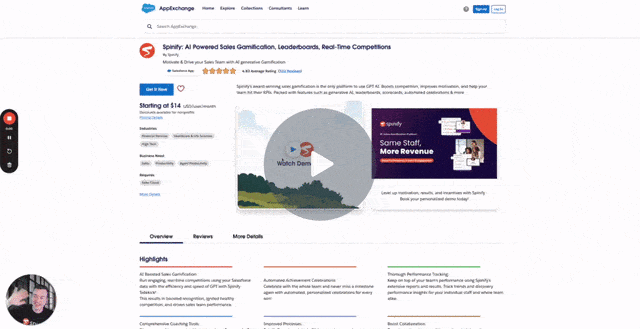
Next Steps:
- Revisit Our Foundational Guides:
- Apply These Techniques:
- Start implementing the steps outlined in this guide, continually adapting based on feedback and performance data.
- Explore Practical Implementations:
- Dive into our upcoming articles, such as Turn Salesforce Reports into Leaderboards, for more hands-on guidance.
- Schedule a Spinify Demo:
- See firsthand how Spinify can help your team achieve desired results while maintaining high user engagement and sales performance.
By integrating these best practices and leveraging the advanced capabilities of Spinify, your organization will not only learn how to effectively gamify Salesforce but also foster a culture of continuous improvement, employee engagement, and outstanding sales productivity.

